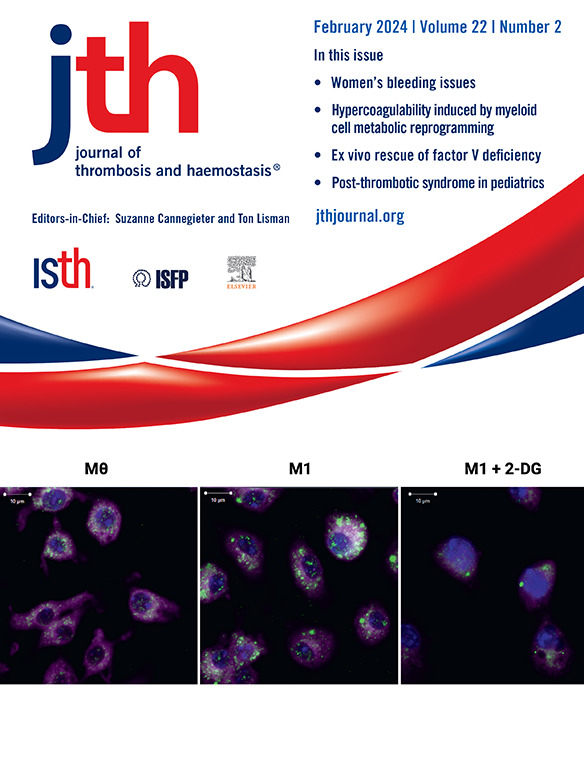2025年弥散性血管内凝血的更新定义和评分:来自ISTH SSC弥散性血管内凝血小组委员会的交流
IF 5.5
2区 医学
Q1 HEMATOLOGY
引用次数: 0
摘要
令人信服的证据支持需要更新2001年弥散性血管内凝血(DIC)的定义和诊断,以反映我们目前对疾病病理生理学的理解。DIC长期以来被认为是由各种潜在原因引起的严重且无法治疗的后遗症,只有在治疗诱发病因后才能解决。最近的观点逐渐认识到,通过早期发现和治疗,可以降低与心血管疾病相关的死亡率。国际血栓形成和止血学会DIC科学和标准化委员会提出了DIC的最新定义:“一种获得性的、危及生命的血管内疾病,以全身凝血激活、纤维蛋白溶解失调和内皮损伤为特征,导致微血栓形成。”DIC有多种潜在病因,可从早期无症状发展到晚期出血和/或器官功能障碍。”根据这一更全面的定义,我们建议建立更有针对性的诊断标准,根据潜在疾病检测早期DIC。我们还建议修改明显的DIC诊断标准和晚期DIC评分。这些共识驱动的修改反映了自2001年最初定义以来获得的知识,这促进了DIC的临床实践和研究。修订后的框架有望促进更精确和更早期的诊断,改善临床研究中的患者分层,并促进依赖病理生理背景的靶向治疗的发展。本文章由计算机程序翻译,如有差异,请以英文原文为准。
Updated definition and scoring of disseminated intravascular coagulation in 2025: communication from the ISTH SSC Subcommittee on Disseminated Intravascular Coagulation
Compelling evidence supports the need to update the 2001 definition and diagnosis of disseminated intravascular coagulation (DIC) to reflect our current understanding of disease pathophysiology. DIC has been long considered a critical and untreatable sequela of various underlying causes, with resolution only after treatment of the eliciting etiology. Recent views have evolved to appreciate that DIC-associated mortality may be reduced by detection and treatment at an early stage. The International Society on Thrombosis and Haemostasis Scientific and Standardization Committee on DIC proposes an updated definition of DIC: “an acquired, life-threatening intravascular disorder characterized by systemic coagulation activation, dysregulated fibrinolysis, and endothelial injury, resulting in microthrombosis. DIC arises from various underlying etiologies and progresses from a potentially asymptomatic early phase to an advanced phase with hemorrhage and/or organ dysfunction.” In accordance with this more comprehensive definition, we propose to establish more tailored diagnostic criteria that detect early-phase DIC based on the underlying disease. We also propose a modification to overt DIC diagnostic criteria and scoring for late-phase DIC. These consensus-driven modifications reflect knowledge obtained since the original 2001 definition, which advanced clinical practice and research on DIC. This revised framework is anticipated to foster more precise and earlier diagnoses, improve patient stratification in clinical studies, and facilitate the development of targeted therapies dependent on pathophysiological context.
求助全文
通过发布文献求助,成功后即可免费获取论文全文。
去求助
来源期刊
CiteScore
24.30
自引率
3.80%
发文量
321
审稿时长
1 months
期刊介绍:
The Journal of Thrombosis and Haemostasis (JTH) serves as the official journal of the International Society on Thrombosis and Haemostasis. It is dedicated to advancing science related to thrombosis, bleeding disorders, and vascular biology through the dissemination and exchange of information and ideas within the global research community.
Types of Publications:
The journal publishes a variety of content, including:
Original research reports
State-of-the-art reviews
Brief reports
Case reports
Invited commentaries on publications in the Journal
Forum articles
Correspondence
Announcements
Scope of Contributions:
Editors invite contributions from both fundamental and clinical domains. These include:
Basic manuscripts on blood coagulation and fibrinolysis
Studies on proteins and reactions related to thrombosis and haemostasis
Research on blood platelets and their interactions with other biological systems, such as the vessel wall, blood cells, and invading organisms
Clinical manuscripts covering various topics including venous thrombosis, arterial disease, hemophilia, bleeding disorders, and platelet diseases
Clinical manuscripts may encompass etiology, diagnostics, prognosis, prevention, and treatment strategies.

 求助内容:
求助内容: 应助结果提醒方式:
应助结果提醒方式:


